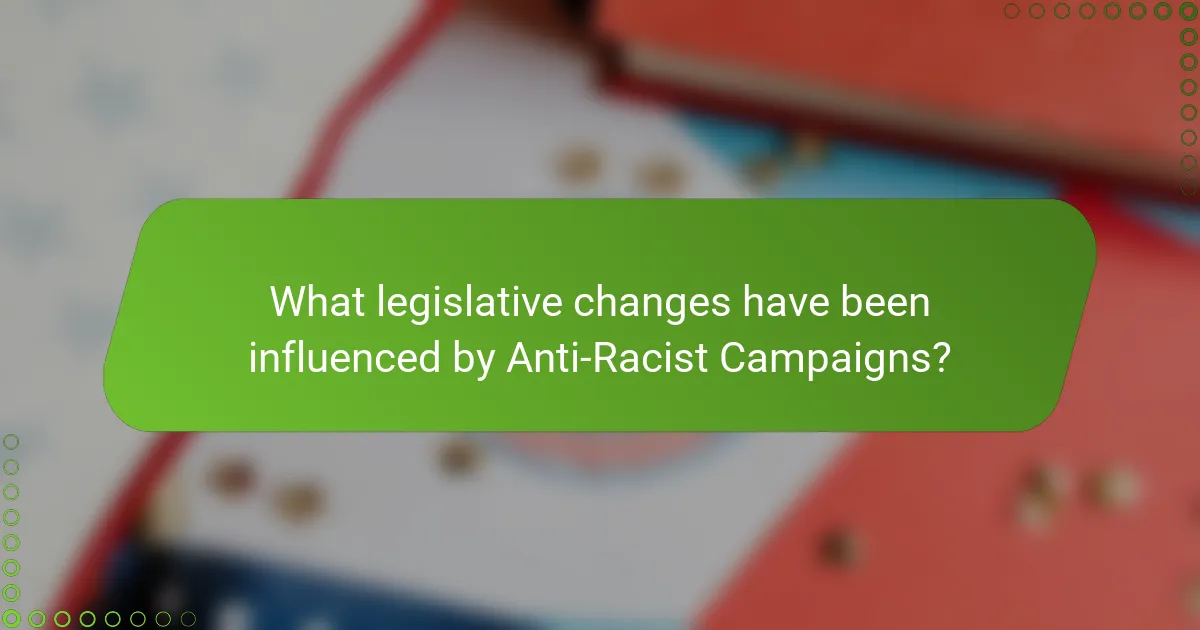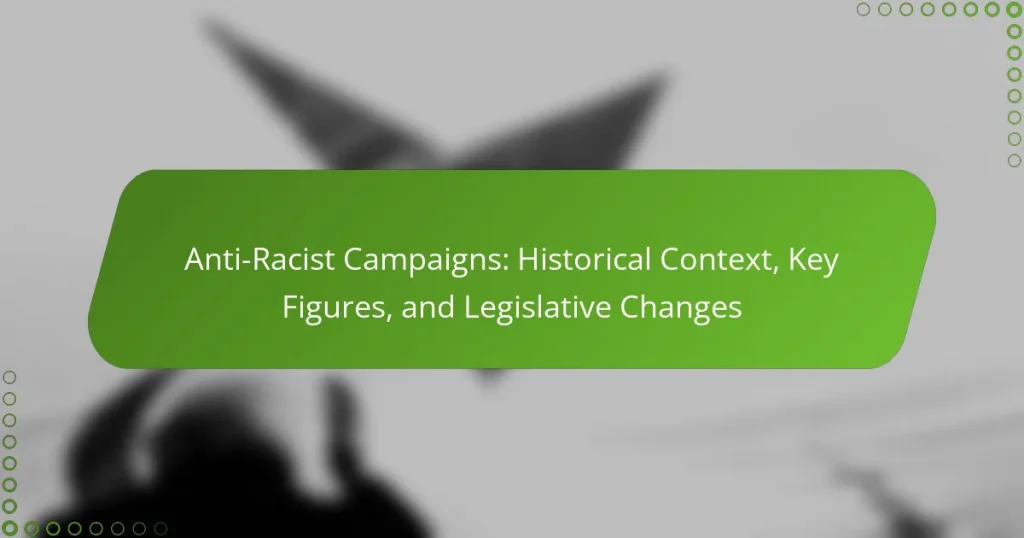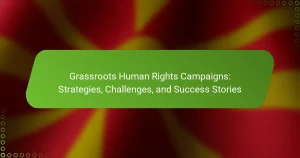Anti-racist campaigns are organized efforts aimed at combating racism and promoting racial equality through various methods such as protests, educational initiatives, and policy advocacy. The article examines the historical context of these campaigns, highlighting significant movements like the Civil Rights Movement and key legislative changes including the Civil Rights Act of 1964, the Voting Rights Act of 1965, and the Fair Housing Act of 1968. It discusses the growing public support for anti-racist initiatives and the influence of contemporary movements like Black Lives Matter on current policy discussions. Additionally, the article explores future directions for anti-racist campaigns, emphasizing systemic change, community engagement, and the importance of data-driven approaches in addressing racial injustices.

What are Anti-Racist Campaigns?
Anti-racist campaigns are organized efforts aimed at combating racism and promoting racial equality. These campaigns can take various forms, including protests, educational programs, and policy advocacy. They seek to raise awareness about systemic racism and its impacts on marginalized communities. Historical examples include the Civil Rights Movement in the United States, which fought against segregation and discrimination. Data from the Pew Research Center indicates that public support for anti-racist initiatives has grown in recent years. These campaigns often involve collaboration among community organizations, activists, and policymakers to effect change.
How did Anti-Racist Campaigns originate?
Anti-racist campaigns originated as a response to systemic racism and discrimination. They began gaining prominence in the mid-20th century. The civil rights movement in the United States was a significant catalyst. Activists sought to address racial injustices through protests and legal challenges. Organizations like the NAACP played a crucial role in these efforts. Internationally, anti-colonial movements also contributed to the rise of anti-racist sentiments. The global struggle against apartheid in South Africa further galvanized support for anti-racist campaigns. These movements aimed to promote equality and human rights for marginalized communities.
What historical events influenced the rise of Anti-Racist Campaigns?
The rise of Anti-Racist Campaigns was influenced by several key historical events. The abolition of slavery in the 19th century marked a significant shift in societal attitudes towards race. The Civil Rights Movement in the 1950s and 1960s highlighted systemic racism and mobilized activism. The publication of works like “The Souls of Black Folk” by W.E.B. Du Bois in 1903 raised awareness about racial injustice. The end of apartheid in South Africa in the early 1990s inspired global anti-racist efforts. Additionally, the Black Lives Matter movement, initiated in 2013, reignited discussions around racial inequality. Each of these events contributed to a growing recognition of racism and the need for organized resistance.
How have societal attitudes shaped these campaigns over time?
Societal attitudes have significantly influenced anti-racist campaigns over time. Changing perceptions of race and equality have driven the focus and strategies of these campaigns. For instance, the civil rights movement in the 1960s emerged from a growing societal recognition of racial injustices. This shift led to increased public support for legislative changes, such as the Civil Rights Act of 1964.
In the 1980s and 1990s, attitudes towards multiculturalism began to rise, prompting campaigns to promote diversity and inclusion. These societal shifts resulted in broader coalitions and more comprehensive approaches to combating racism.
Recent movements, like Black Lives Matter, reflect a contemporary response to persistent racial inequalities. Public sentiment, fueled by social media and grassroots organizing, has amplified calls for justice and accountability. Overall, societal attitudes have continuously shaped the goals, methods, and successes of anti-racist campaigns throughout history.
What are the goals of Anti-Racist Campaigns?
The goals of anti-racist campaigns are to eliminate systemic racism and promote equality. These campaigns aim to raise awareness about racial injustices. They seek to educate individuals on the impact of racism. Advocacy for policy changes is a crucial objective. Anti-racist campaigns also aim to foster solidarity among diverse communities. They promote inclusivity and celebrate cultural diversity. Additionally, these campaigns strive to empower marginalized voices. Research indicates that effective anti-racist initiatives can lead to measurable societal change.
How do these campaigns aim to address systemic racism?
Anti-racist campaigns aim to address systemic racism by raising awareness, promoting education, and advocating for policy changes. They highlight the historical context and impact of racism on marginalized communities. Campaigns often utilize social media to amplify voices and share personal stories. They seek to engage diverse audiences in discussions about equity and justice. Many campaigns collaborate with organizations to influence legislation that dismantles discriminatory practices. Research shows that public awareness increases support for anti-racist policies. For instance, the Black Lives Matter movement has significantly impacted public discourse and policy discussions.
What impact do Anti-Racist Campaigns seek to achieve in communities?
Anti-Racist Campaigns seek to achieve social equity and justice in communities. They aim to dismantle systemic racism and promote inclusivity. These campaigns often raise awareness about racial injustices. They encourage dialogue among diverse community members. Anti-Racist Campaigns also advocate for policy changes to support marginalized groups. Research shows that such campaigns can lead to improved community relations. For example, the “Black Lives Matter” movement has sparked widespread discussions on race. Statistics indicate that communities engaged in anti-racist efforts report higher levels of understanding and cooperation.
Who are the key figures in Anti-Racist Campaigns?
Key figures in anti-racist campaigns include Martin Luther King Jr., Malcolm X, and Rosa Parks. Martin Luther King Jr. was a leader in the American civil rights movement. He advocated for nonviolent resistance to combat racial injustice. Malcolm X promoted a more militant approach to achieving racial equality. Rosa Parks is famously known for her pivotal role in the Montgomery Bus Boycott. Other notable figures include Nelson Mandela, who fought against apartheid in South Africa. Angela Davis has also been a significant voice in anti-racist activism. Each of these individuals contributed to raising awareness and driving legislative changes against racial discrimination. Their efforts have shaped the landscape of anti-racist movements globally.
What roles have activists played in shaping these movements?
Activists have played crucial roles in shaping anti-racist movements. They have mobilized communities and raised awareness about racial injustices. Activists organized protests, marches, and campaigns to demand change. Historical examples include the Civil Rights Movement led by figures like Martin Luther King Jr. and Malcolm X. Their efforts led to significant legislative changes, such as the Civil Rights Act of 1964. Activists utilized media to amplify their messages and reach broader audiences. They have also created coalitions to unite various groups against racism. Through grassroots organizing, activists have influenced public opinion and policy. Their persistent advocacy has been vital in challenging systemic racism.
How have public figures contributed to the visibility of Anti-Racist Campaigns?
Public figures have significantly enhanced the visibility of anti-racist campaigns through advocacy and public engagement. Celebrities and leaders use their platforms to raise awareness about racial injustices. For example, during the Black Lives Matter protests in 2020, numerous high-profile individuals voiced their support on social media. This led to increased public discourse and media coverage surrounding racial equality. Studies show that celebrity endorsements can influence public opinion and mobilize support for social causes. Their involvement often attracts younger audiences who may not engage otherwise. Public figures also participate in campaigns, further legitimizing the movement. Their visibility can lead to greater donations and support for anti-racist organizations. Overall, the contributions of public figures play a crucial role in amplifying the message of anti-racist campaigns.

What legislative changes have been influenced by Anti-Racist Campaigns?
Anti-racist campaigns have influenced several significant legislative changes. The Civil Rights Act of 1964 was a direct result of anti-racist activism. This law prohibited discrimination based on race, color, religion, [censured], or national origin. The Voting Rights Act of 1965 also emerged from these campaigns, aiming to eliminate barriers to voting for African Americans. Additionally, the Fair Housing Act of 1968 addressed racial discrimination in housing. More recently, movements like Black Lives Matter have spurred discussions on police reform legislation. These legislative changes reflect the ongoing impact of anti-racist campaigns in shaping policies that promote equality and justice.
How have Anti-Racist Campaigns impacted legislation?
Anti-Racist Campaigns have significantly influenced legislation by raising awareness and advocating for policy changes. These campaigns have mobilized public opinion against systemic racism. For example, the Black Lives Matter movement led to the introduction of police reform bills in various states. In 2020, the George Floyd Justice in Policing Act was proposed in Congress, aiming to address police misconduct. Legislative bodies have responded to increased public pressure by enacting laws promoting racial equality. The push for anti-discrimination laws has also gained momentum due to these campaigns. Studies show that public support for anti-racist legislation has surged following high-profile protests. Overall, Anti-Racist Campaigns have created a legislative environment more receptive to addressing racial injustices.
What specific laws have been enacted as a result of these campaigns?
The specific laws enacted as a result of anti-racist campaigns include the Civil Rights Act of 1964. This law prohibits discrimination based on race, color, religion, [censured], or national origin. Another significant law is the Voting Rights Act of 1965. This act aimed to eliminate barriers to voting for African Americans. Additionally, the Fair Housing Act of 1968 prohibits discrimination in housing based on race, color, religion, or national origin. These laws were direct responses to the civil rights movement and its campaigns for equality. They represent significant legislative changes that aimed to address systemic racism in the United States.
How do these legislative changes reflect the goals of Anti-Racist Campaigns?
Legislative changes often reflect the goals of Anti-Racist Campaigns by promoting equity and justice. These changes aim to dismantle systemic racism in laws and policies. For example, the Civil Rights Act of 1964 sought to end discrimination based on race. This act aimed to ensure equal access to public spaces and employment opportunities. Additionally, recent reforms in police practices address racial profiling and excessive force. These reforms align with the demands of anti-racist activists for accountability and transparency. Thus, legislative changes serve as tangible steps towards achieving the objectives of anti-racist movements.
What challenges have Anti-Racist Campaigns faced in achieving legislative change?
Anti-racist campaigns have faced significant challenges in achieving legislative change. Political resistance often arises from lawmakers who oppose anti-racist measures. Many legislators prioritize maintaining the status quo over enacting reforms. Public opinion can also be divided, complicating the push for change. Misinformation about the goals of anti-racist campaigns can create additional barriers. Funding limitations restrict the resources available for advocacy and outreach. Furthermore, systemic racism within institutions can hinder progress. Historical context shows that similar movements have struggled with these issues in the past. For example, the civil rights movement faced significant opposition despite widespread support for its goals.
What opposition do these campaigns encounter from various sectors?
Anti-racist campaigns encounter opposition from various sectors, including political, social, and economic groups. Political opposition often arises from parties that resist changes to existing power structures. Some social groups may feel threatened by the calls for equity and inclusion. Economic sectors, particularly those benefiting from systemic inequalities, may oppose reforms that could disrupt their profits. For instance, industries reliant on low-wage labor may resist labor rights initiatives linked to anti-racist efforts. Additionally, misinformation campaigns can undermine public support for these initiatives. Historical resistance from groups like the Ku Klux Klan exemplifies the long-standing backlash against anti-racist movements.
How have grassroots movements responded to these challenges?
Grassroots movements have responded to challenges by organizing protests and awareness campaigns. They mobilize communities to advocate for policy changes. These movements often utilize social media to amplify their messages. They create coalitions with other organizations to strengthen their efforts. Grassroots initiatives focus on education to inform the public about systemic racism. They also engage in direct action to confront discriminatory practices. Historical examples include the Civil Rights Movement, which led to significant legislative changes. Current movements continue to push for reforms in policing and criminal justice.

What are the future directions for Anti-Racist Campaigns?
Future directions for anti-racist campaigns include increased focus on systemic change and community engagement. Campaigns will likely prioritize education on racial equity in schools and workplaces. Digital activism will continue to play a crucial role in mobilizing support and raising awareness. Collaborations with grassroots organizations are expected to strengthen local efforts. Data-driven approaches will enhance the effectiveness of campaigns by identifying key areas for intervention. Legislative advocacy will remain essential to push for policy changes that address racial injustices. Furthermore, campaigns may increasingly emphasize intersectionality, recognizing the interconnectedness of various forms of discrimination. These trends reflect a growing understanding of the complexities of racism and the need for comprehensive strategies.
How can individuals contribute to Anti-Racist Campaigns?
Individuals can contribute to anti-racist campaigns by educating themselves and others about racism. This includes understanding historical contexts and current issues related to racial injustice. Engaging in open conversations about race can help raise awareness. Volunteering with organizations that promote racial equality is another effective way to contribute. Additionally, individuals can support anti-racist policies by advocating for legislative changes. Participating in peaceful protests and demonstrations also amplifies the message against racism. Financially supporting anti-racist initiatives can further bolster these efforts. Collectively, these actions create a more inclusive society and challenge systemic racism.
What actions can communities take to support these initiatives?
Communities can take several actions to support anti-racist initiatives. They can organize educational workshops to raise awareness about racism and its impacts. Communities can also engage in local advocacy to influence policy changes that promote equity. Supporting local businesses owned by marginalized groups is another effective action. Additionally, communities can participate in peaceful protests to demonstrate solidarity against racism. Collaborating with organizations focused on racial justice amplifies community efforts. Volunteering time and resources to support anti-racist organizations strengthens their impact. Finally, communities can create safe spaces for dialogue about race and discrimination. These actions collectively contribute to fostering a more inclusive society.
How can education play a role in advancing Anti-Racist efforts?
Education can advance Anti-Racist efforts by promoting awareness and understanding of racial issues. It equips individuals with knowledge about historical injustices and systemic racism. This understanding fosters empathy and encourages critical thinking. Educational programs can include diverse perspectives and narratives. For instance, teaching about civil rights movements highlights the struggles against racism. Studies show that inclusive curricula can reduce prejudice among students. Additionally, education can empower individuals to advocate for change in their communities. By creating informed citizens, education lays the groundwork for a more equitable society.
What best practices should be followed in Anti-Racist Campaigns?
Effective anti-racist campaigns should prioritize community engagement and education. Engaging local communities fosters trust and collaboration. Education initiatives must address systemic racism and its impacts. Campaigns should use data to highlight disparities in various sectors. Clear messaging that resonates with diverse audiences is essential. Inclusivity in campaign planning ensures representation of marginalized voices. Collaborating with established organizations can amplify efforts and resources. Regular evaluation of campaign effectiveness helps refine strategies and approaches.
How can campaigns effectively engage diverse audiences?
Campaigns can effectively engage diverse audiences by employing inclusive messaging and targeted outreach strategies. Inclusive messaging resonates with various cultural backgrounds and experiences. It is essential to understand the unique values and concerns of different communities. Tailoring content to reflect these values fosters connection and relevance. Utilizing multiple communication channels ensures broader reach. Social media, community events, and local partnerships enhance visibility. Research shows that campaigns using culturally relevant imagery and language increase engagement. For instance, a study by the Pew Research Center found that diverse representation in media leads to higher audience trust and participation. Engaging community leaders as advocates can also amplify campaign messages. This approach builds credibility and encourages grassroots involvement.
What strategies have proven successful in raising awareness and effecting change?
Successful strategies for raising awareness and effecting change include grassroots organizing, education, and coalition-building. Grassroots organizing mobilizes communities to advocate for anti-racist initiatives. Education efforts inform the public about systemic racism and its impacts. Coalition-building brings together diverse groups to amplify voices and resources. Historical examples show that these strategies have led to significant legislative changes. The Civil Rights Movement utilized grassroots organizing to achieve the Voting Rights Act of 1965. Education campaigns, like those led by the NAACP, increased public understanding and support for anti-racist policies. Coalition efforts, such as the Women’s March, have united various social justice movements, leading to broader awareness and action against racism.
Anti-racist campaigns are organized efforts aimed at combating racism and promoting racial equality through various forms such as protests, educational programs, and policy advocacy. The article explores the historical context of these campaigns, highlighting key figures like Martin Luther King Jr. and significant events that shaped their emergence, including the Civil Rights Movement and the Black Lives Matter movement. It also examines the goals of anti-racist campaigns, their impact on legislation, and the challenges they face in achieving systemic change. Additionally, the article discusses the role of education and community engagement in advancing anti-racist efforts, as well as best practices for effectively raising awareness and fostering inclusivity.




